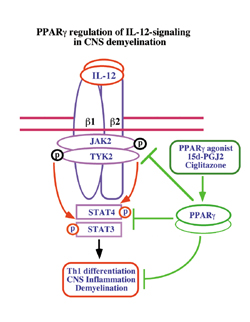
Model illustrating activation of PPAR-gamma by agonists that in turn blocks the IL-12-induced activation of JAK-STAT pathway and inhibits Th1 differentiation, CNS inflammation, and demyelination.
Research links diabetes drug, multiple sclerosis

John Bright, Ph.D.

Chandramohan Natarajan, Ph.D.
Living with multiple sclerosis takes a toll on body and mind. Feelings of dread and frustration, guilt and loss drain self-esteem and damage relations. A longing for the old swagger, the old self-confidence is sublimated, at night, in dreams of running, of flying, of strength and grace restored.
There is no cure for this inflammatory demyelinating disease of the central nervous system that afflicts 2.5 million people worldwide and leaves about 25 percent of them wheelchair bound. But there is reason to believe that a handful of drugs currently used to treat diabetes might be effective in halting the inflammatory process involved in multiple sclerosis and other diseases in which the immune system has run similarly amok.
Researchers from the department of Neurology at Vanderbilt reported in the April issue of Genes and Immunity their progress in defining the mechanism of action for these drugs. Using as a model an MS-like disease found in mice, John J. Bright, Ph.D., and post-doctoral fellow Chandramohan Natarajan, Ph.D., showed that the drugs, known as PPAR-gamma agonists, reduced the incidence and severity of the disease. The drugs specifically decrease production and signaling of the protein called IL-12, with a consequent inhibition of the T cell-mediated immune response characteristic of inflammatory and autoimmune diseases.
“I hope this is a new beginning for using these PPAR-gamma agonists for not only multiple sclerosis,” said Bright, who is an assistant professor of Neurology, “but also for Th1-mediated immune diseases as a whole, including Type 1 diabetes, rheumatoid arthritis, inflammatory bowel syndrome, myocarditis, and psoriasis, among others.”
The researchers tested the effects of two such agonists, which are compounds that attach to a specific docking site inside cells called peroxisome proliferator activated receptor-gamma, or PPAR-gamma, and trigger activation of genes with extensive developmental and regulatory effects. Among its many other duties, PPAR-gamma is a potent regulator of glucose metabolism. Commercially available drugs such as Rezulin, Actos, and Avandia act on the receptor to reduce levels of plasma glucose and insulin resistance in patients with Type 2 diabetes.
Bright induced the MS-like disease known as experimental allergic encephalomyelitis (EAE) in mice, then treated the mice with both a natural and a synthetic PPAR-gamma agonist. The pathogenesis of EAE/MS involves activation of macrophage or microglial immune “destroyer” cells, differentiation of T-helper 1 (Th1) immune cells, and secretion of inflammatory signaling proteins, like IL-12, in the central nervous system.
Bright and others had previously shown that the inhibition of IL-12 production or IL-12 signaling through a pathway called JAK-STAT prevents Th1 differentiation and pathogenesis of EAE. It is activation of the Th1 arm of the immune system that causes central nervous system inflammation and loss of the insulating myelin sheath from nerve cells that is critical to the conduction of electrical impulses to and from the brain.
In this study, the researchers extended the work by showing that the agonists induce activation of PPAR-gamma that in turn blocks the IL-12-induced activation of the JAK-STAT pathway and inhibits Th1 differentiation. That blocking of IL-12 signaling by agonists can be reversed by removing the drugs gives further support to the idea that this pathway is critical to how the drugs work.
“There may be other pathways affected by PPAR-gamma agonists,” Bright said. “We don’t say that this is the only one, but at least we can say now that inhibition of the JAK-STAT pathway is one way these drugs regulate IL-12/Th1 axis in EAE. And I think there will be many other disease conditions related to activation of the JAK-STAT signaling pathway that may also be treated by these drugs.”
Clarification of the mechanism behind PPAR-gamma agonists will help design better targeted drugs with fewer side effects, Bright believes. One of the diabetes drugs, Rezulin, was taken off the market in 2000 after it was shown to cause liver toxicity in some patients, most likely due to non-specific action of the drug.
Bright is currently at work screening other synthetic PPAR-gamma agonists and natural, plant-based compounds, to test their ability to block the JAK-STAT pathway and the IL-12/Th1 axis, and to ameliorate EAE in mice. Other projects involve working with transgenic mice that express IL-12 only in the brain, as well as heterozygote PPAR-gamma knockout mice, to further define the mechanism of action behind the drugs.
The research was supported in part by grants from the National Multiple Sclerosis Society and the National Institutes of Health.













